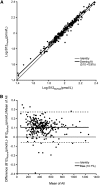Biomarkers of vitamin B-12 status in NHANES: a roundtable summary
- PMID: 21593512
- PMCID: PMC3127527
- DOI: 10.3945/ajcn.111.013243
Biomarkers of vitamin B-12 status in NHANES: a roundtable summary
Abstract
A roundtable to discuss the measurement of vitamin B-12 (cobalamin) status biomarkers in NHANES took place in July 2010. NHANES stopped measuring vitamin B-12-related biomarkers after 2006. The roundtable reviewed 3 biomarkers of vitamin B-12 status used in past NHANES--serum vitamin B-12, methylmalonic acid (MMA), and total homocysteine (tHcy)--and discussed the potential utility of measuring holotranscobalamin (holoTC) for future NHANES. The roundtable focused on public health considerations and the quality of the measurement procedures and reference methods and materials that past NHANES used or that are available for future NHANES. Roundtable members supported reinstating vitamin B-12 status measures in NHANES. They noted evolving concerns and uncertainties regarding whether subclinical (mild, asymptomatic) vitamin B-12 deficiency is a public health concern. They identified the need for evidence from clinical trials to address causal relations between subclinical vitamin B-12 deficiency and adverse health outcomes as well as appropriate cutoffs for interpreting vitamin B-12-related biomarkers. They agreed that problems with sensitivity and specificity of individual biomarkers underscore the need for including at least one biomarker of circulating vitamin B-12 (serum vitamin B-12 or holoTC) and one functional biomarker (MMA or tHcy) in NHANES. The inclusion of both serum vitamin B-12 and plasma MMA, which have been associated with cognitive dysfunction and anemia in NHANES and in other population-based studies, was preferable to provide continuity with past NHANES. Reliable measurement procedures are available, and National Institute of Standards and Technology reference materials are available or in development for serum vitamin B-12 and MMA.
Figures

References
-
- Green R, Miller JW. Vitamin B12 deficiency is the dominant nutritional cause of hyperhomocysteinemia in a folic acid-fortified population. Clin Chem Lab Med 2005;43:1048–51 - PubMed
Publication types
MeSH terms
Substances
Grants and funding
LinkOut - more resources
Full Text Sources
Miscellaneous

